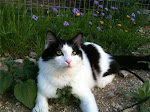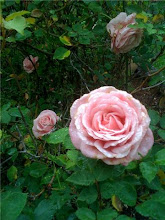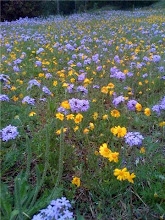The garden is strong this year. Tomatoes are taller than me! I have 8 heirloom tomatoes growing in one of the raised beds. While checking in on the tomato babies I found this striking pink moth on one of the leaves. I became mesmerized by this pink moth - so pretty and unique. I looked it up and identified it on the butterfliesandmoths.org website. This pink beauty is Pyrausta inornatalis,
or better known as southern pink moth.
Further down the tomato patch, I found a large section of leaves had disappeared! There's only one thing I know that can eat so much in so little time! Tomato hornworm! Herbhusband was shocked and made it his personal quest to find the bugger...and he did and boy was it big!
Tomato hornworms can eat and defoliate entire plants - leaving nothing left but some stripped stems. They tend to be 3-5 inches long and have a harmless spike near the rear part of their bodies. The horn looks fierce, but it won't hurt you. Even though I know that, I avoid touching it anyway. Here's the hornworm shown beside an i-phone just for size comparison. They like to feed on nightshade plants such as peppers, potatoes, tomatoes and eggplants. I haven't had any trouble with them on anything other than tomatoes. They make a delicious treat for the birds so I toss them out in hopes a bird will come and take them away. The survivors turn into large dusty brown moths that I sometimes confuse for a hummingbird when I see them flying around. They have extremely long proboscis and they love to feed on tubular flowers in the late evening. They are kind of neat to watch. Each year, in late June or so, I see them feeding on the spider lily nectar at dusk.
The chard is doing very well. It's so fun to go into the garden and harvest these large flouncy leaves on bright red stalks. Chard is a bitter so it's excellent to add to your diet. Bitters stimulate digestion and give our digestive system the added oomph it needs to get things done.
Our lizard friends also enjoy the garden. I love anoles. These lizards are not only beneficial; they are very interesting to watch. Hummingbirds frequent the garden, too - especially since I have betony growing in two of the beds. The red throated flowers are a hummingbird favorite. Betony is in full bloom right now and adds visual interest as well as medicinal qualities so it's a win/win addition to any garden. That's the beauty of organic gardening - whether you're growing medicinal herbs or food, you can't go wrong extending a natural and safe environment for beneficial garden critters. Yes, the not so good bugs are there, but harboring a safe nurturing environment for their natural predators keeps everything in balance and harmony.
Autumn's Bounty
3 months ago




















+and+wildflowers+loving+the+field.jpg)








No comments:
Post a Comment